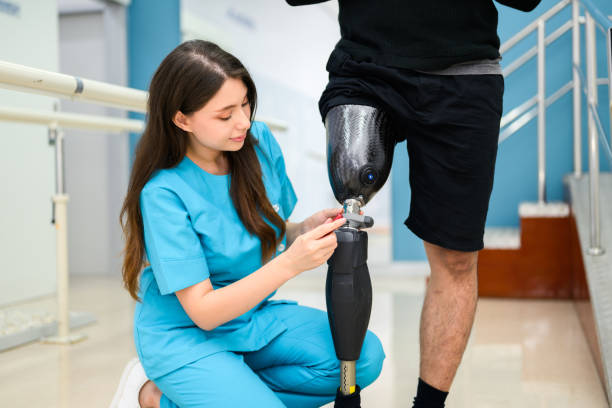Wearing a transtibial prosthesis can feel new and different at first. But with the right exercises and support, your body will grow stronger and steadier.
If you live in Singapore and have just started using a prosthesis or if you are helping someone who has, this guide offers clear, easy tips. You will learn about simple exercises to build strength, improve balance, and stay flexible.
We will also share where to find good prosthetic services and how physiotherapy for transtibial prosthesis can help you every day. Taking small steps each day helps you feel more confident and comfortable with your new limb.
What Is a Transtibial Prosthesis?
A transtibial prosthesis takes the place of the part of your leg under the knee. It helps you stand, walk, and even run again. Your leg and body must get used to it, and that takes work.
To do that, you move, stretch, and train your body through special exercises.
Why Physical Therapy Helps
Physical therapy teaches your body how to move with your new leg. It also keeps your muscles strong and your joints moving smoothly.
Your goal is not just to walk—you want to feel free and safe when you move.
What You Work On in Therapy
Build Up Muscle Power
Your hips and thighs carry more weight now. You’ll need to train, lift, and push those muscles to get strong. This makes walking with the prosthesis easier.
Steady Your Balance
At first, standing might feel wobbly. Your brain must learn, test, and adjust with each step. You practise standing still and walking until your body remembers what to do.
Stretch and Loosen
Stiff legs don’t move well. Therapy helps you bend, slide, and wiggle your joints so your steps feel smooth and easy.
Begin Therapy in Singapore
Singapore has many places that offer prosthetics services. You can speak to a doctor or a therapist to help you begin. Therapists who know physiotherapy for transtibial prosthesis can guide you in simple, helpful ways.
Ask lots of questions. Share what feels hard. When you and your therapist talk and plan together, you move forward faster.
Easy Exercises at Home
You can try some simple exercises at home once your therapist says it’s safe. These moves help you build strength, steady your balance, and keep your joints loose. You don’t need fancy tools—just a safe, quiet space and a chair or wall for support.
Chair Leg Lifts
Sit on a sturdy chair with both feet flat on the floor. Slowly lift your prosthetic leg until it’s straight. Hold it up for a few seconds, then gently lower it back down. Do this 10 to 15 times. This move strengthens your thigh muscles and helps you stand and walk with more control.
Side Leg Raises
Lie down on your stronger side with your legs straight. Slowly lift your prosthetic leg up, then lower it with care. This exercise strengthens your hip muscles, which help keep you upright while walking.
Heel Slides
Lie on your back with both legs stretched out. Gently slide your prosthetic heel toward your bottom, then slide it back. This keeps your knee flexible and makes bending easier.
Balance Steps
Stand near a chair or wall. Try to balance on your prosthetic leg for 5–10 seconds. This helps your body learn balance and improves your confidence.
Helpful Daily Habits
You can grow stronger by doing small, steady things each day. These little steps help your therapy work better and faster. They keep your body active and your mind focused. Good habits also make your prosthesis feel more like a natural part of you. Let’s look at a few easy things you can do every day.
Wear Your Prosthesis Each Day
Slip on your prosthesis every morning, even if it’s just for a short while. Start small, then add a little more time each day. This helps your leg learn how to carry weight and move with the new limb. The more you wear it, the more natural it feels.
Look at Your Skin
Peek at your skin where the prosthesis touches. If you spot any red marks, blisters, or sore spots, tell someone who can help. Healthy skin keeps you comfortable and prevents bigger problems later on.
Walk Around Often
Take short walks around your home or outside. Every step you take builds strength and keeps your joints moving. Walking also lifts your mood.
Use Support If You Need It
Hold a cane or walker if it helps you feel safe. You’ll know when it’s time to move on without it.
Keep Going and Stay Strong
Some days feel easy. Some days feel hard. That’s okay. Set small goals and celebrate each one. Each step counts.
If you feel sad or tired, talk to your family, your therapist, or a friend. They want to help you.
Finding Prosthetic Services in Singapore
You can visit hospitals, clinics, or therapy centres in Singapore to find good prosthetics services. These places can help you choose, fit, and adjust your prosthesis.
They also work closely with therapists to guide your care and make sure everything feels right.
Family and Friends Can Help Too
When your family and friends stand by you, it helps a lot. They can cheer, lift, or listen when you need support. You can even ask them to join you in therapy or walks.
Mistakes to Watch Out For
Stopping Too Soon
Sometimes people stop their therapy early because they feel better. But muscles still need time to grow and stay strong. When you skip sessions, your progress can slow down. Therapy isn’t just about walking—it also helps you move the right way and avoid injury. So, even if you feel fine, keep going until your therapist says you’re ready.
Doing Too Much
It’s easy to rush ahead and do too much too soon. But your body needs time to adjust. If you strain your muscles or ignore pain, you might hurt yourself. Take things slow. Rest when you need it. That way, you build strength without risk.
Wearing It the Wrong Way
If your prosthesis feels loose, tight, or painful, don’t wait. A bad fit can cause sores or change the way you walk. Visit your prosthetist and get it fixed early.
Conclusion
Using a transtibial prosthesis is a step-by-step journey. With regular therapy, daily practice, and support from your care team, you will move better and feel more independent.
Singapore offers many trusted places for prosthetics services and skilled physiotherapy for transtibial prosthesis. Keep wearing your prosthesis, follow your therapy plan, and be patient with yourself. Each small effort helps you grow stronger and walk more comfortably.
Remember, every step forward is progress. You are doing well, and your body will keep improving with time.






